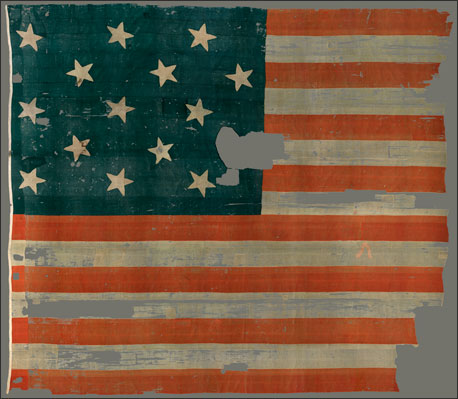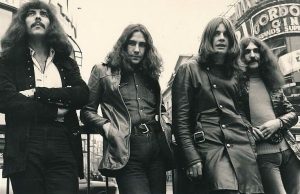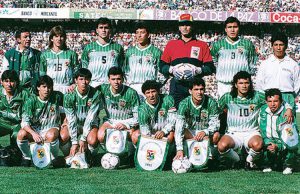Francis Scott Key was born on August 1, 1779 in Terra Rubra, Maryland. After graduating college, Key began to study law in hopes of becoming an attorney.1 Soon after, Keys got married and had eleven children and moved to Georgetown where he started his own practice.2 Key became very successful in his work as a lawyer, and for hobbies he sang for the church and wrote poems, a lot of which are still appreciated today. When the War of 1812 broke out, Key enlisted in the US army.3

Francis Scott Key was sent to a British ship to negotiate the release of certain prisoners. Upon Key’s arrival to the ship, he showed the Commodore of the ship letters from British troops that had been captured by American forces.4 The letters explained how well they were being treated and that they were not harmed in any way. After seeing this, the Commodore let their prisoner William Beanes free, but before the three American men could leave, the British troops were preparing to attack Fort McHenry, and therefore needed to keep them on the ship so that they would not be able to return back to warn the American troops.5
For over twenty-four hours the two sides, American and British, exchanged fire. The British recorded that “over eight hundred shells” were shot at the fort.6 After twenty-four hours of fighting both on land and sea, Francis Scott Key waited for the smoke to clear and saw that the American flag at Fort McHenry was still waving high. Key immediately began to write a poem on what he had witnessed that day. The poem quickly rose to fame and gained the attention of almost every single American.7
Very few people know that the poem went through different phases before becoming the American National Anthem. The original title of the poem was “The Defense of Fort McHenry.” Key later added the tune from an old drinking song called “To Anacreon in Heaven.”8 Later, Congress met to decide on a song for the nation; all songs were rejected, including “The Defense on Fort McHenry.” People that opposed the song claimed that the lyrics were too difficult to sing, it was not martial enough, and it was only about one event in all of American history.9 People who supported the song loved that the lyrics were difficult; that way only professional musicians and singers could sing it before certain important occasions.10
It was not until 1916 that the United States made the “The Star-Spangled Banner” the unofficial nation anthem. Woodrow Wilson was asked to have a “ceremonial song” for the United States, so he picked the most loved song by the people of the United States.11 But it was not until 1931 that Congress adopted the “The Star-Spangled Banner” as the official nation anthem of America. The poem was seen and adored by Americans for the patriotism it stood for and as a reminder of its past victories. This song is now sung before almost every major event in the United States to serve as a reminder of America’s victory against all odds.12
While the first stanza of the poem is widely known and sung today, few have been able to appreciate it in its entirety. Here, then, is the original poem:
O say can you see, by the dawn’s early light,
What so proudly we hail’d at the twilight’s last gleaming,
Whose broad stripes and bright stars through the perilous fight
O’er the ramparts we watch’d were so gallantly streaming?
And the rocket’s red glare, the bomb bursting in air,
Gave proof through the night that our flag was still there,
O say does that star-spangled banner yet wave
O’er the land of the free and the home of the brave?
On the shore dimly seen through the mists of the deep
Where the foe’s haughty host in dread silence reposes,
What is that which the breeze, o’er the towering steep,
As it fitfully blows, half conceals, half discloses?
Now it catches the gleam of the morning’s first beam,
In full glory reflected now shines in the stream,
‘Tis the star-spangled banner – O long may it wave
O’er the land of the free and the home of the brave!
And where is that band who so vauntingly swore,
That the havoc of war and the battle’s confusion
A home and a Country should leave us no more?
Their blood has wash’d out their foul footstep’s pollution.
No refuge could save the hireling and slave
From the terror of flight or the gloom of the grave,
And the star-spangled banner in triumph doth wave
O’er the land of the free and the home of the brave.
O thus be it ever when freemen shall stand
Between their lov’d home and the war’s desolation!
Blest with vict’ry and peace may the heav’n rescued land
Praise the power that hath made and preserv’d us a nation!
Then conquer we must, when our cause it is just,
And this be our motto – “In God is our trust,”
And the star-spangled banner in triumph shall wave
O’er the land of the free and the home of the brave.13
- War of 1812, 2002, s.v. “Key, Francis Scott.” ↵
- War of 1812, 2002, s.v. “Key, Francis Scott.” ↵
- War of 1812, 2002, s.v. “Key, Francis Scott.” ↵
- War of 1812, 2002, s.v. “Key, Francis Scott.” ↵
- UXL Encyclopedia of U.S. History, 2009, s.v. “The Star-Spangled Banner,” by Sonia Benson, Daniel E. Brannen, Jr., and Rebecca Valentine. ↵
- UXL Encyclopedia of U.S. History, 2009, s.v. “The Star-Spangled Banner,” by Sonia Benson, Daniel E. Brannen, Jr., and Rebecca Valentine. ↵
- UXL Encyclopedia of U.S. History, 2009, s.v. “The Star-Spangled Banner,” by Sonia Benson, Daniel E. Brannen, Jr., and Rebecca Valentine. ↵
- “Key, Francis Scott,” in Shaping of America, 1783-1815 Reference Library, edited by Lawrence W. Baker, Richard C. Hanes, Sharon M. Hanes, and Kelly Rudd, Vol. 2, Biographies Volume 1, 257. ↵
- “Key, Francis Scott,” in Shaping of America, 1783-1815 Reference Library, edited by Lawrence W. Baker, Richard C. Hanes, Sharon M. Hanes, and Kelly Rudd, Vol. 2, Biographies Volume 1, 258. ↵
- “Key, Francis Scott.” In Shaping of America, 1783-1815 Reference Library, edited by Lawrence W. Baker, Richard C. Hanes, Sharon M. Hanes, and Kelly Rudd, . Vol. 2, Biographies Volume 1,258. ↵
- “Key, Francis Scott.” In Shaping of America, 1783-1815 Reference Library, edited by Lawrence W. Baker, Richard C. Hanes, Sharon M. Hanes, and Kelly Rudd, Vol. 2, Biographies Volume 1,258. ↵
- UXL Encyclopedia of U.S. History, 2009 s.v. “The Star-Spangled Banner,” by Benson, Sonia, Daniel E. Brannen, Jr., and Rebecca Valentine. ↵
- Francis Scott Key, “The Star-Spangled Banner” (wording of the original handwritten manuscript, in the Museum Department of the Maryland Historical Society). ↵



101 comments
Alexis Soto
I must admit, I tried my best to sing the song. It is incredibly difficult! Nice tough to such a patriotic article. Your article was clear and concise. I knew a little bit about the history of our nations flag, but not our national anthem. It was interesting to learn about its creator and the long process of it being adopted as the official anthem.
Tyler Sleeter
Great article! I had no idea that our national anthem was not chosen until 1931 or that it had so many more verses than just the one we all know. This article is very informative on the background of the poem and how it was chosen as our anthem. I like that it is set to the tune of an old drinking song. I think that it is important to know about the symbols of our country and the anthem is one of those symbols I did not know much about until reading this story.
Ximena Acosta
I loved that your article was informative and to the point. This is a great topic to elaborate on because although the Star Spangled Banner is known worldwide, minimal people know the background of it. I’m glad I learned the creator’s name, Francis Scott Key because he created such an important song for American history. He deserves to be known all over the world. Good job!
Sergio Cervantes
It is always so patriotic and inspiring to hear the words of this wonderful poem being sung before an athletic event. It gives one this sense of pride for their country, especially during the Olympics when our flag is raised at the ceremonies. That being said, before reading this article I was unfamiliar with the whole backstory behind the creation of our national anthem. I never understood what was the purpose for the men going aboard the British ship nor the reason for Francis Scott Key to write the poem. It must have been something to see that the American flag endured such a monstrous bombing.
Nahim Rancharan
This is an amazing article describing one of the most historic and universally recognized songs in American History. I like how the essay captured the fact that the American National Anthem is not only a description of history, but is also rooted from an important historical event in American History. The article effectively shows how important the “Star Spangled Banner” has been for Americans across the nation. It showed how this poem, turned song has provided a solution for a sense of unity and belonging for a nation based in freedom and equality. Good Job!
Mario De Leon
This was a fun read because we all know the Star-Spangled Banner but do we know the man who wrote it? Francis Scott Key was a very accomplished man so I wasn’t surprised that he was the man that came up with the national anthem. I like how the author included the entire poem at the end of the article.
Gabriela Medrano
I loved your article! It’s true the Star Spangled Banner is sung at almost all important events and it sang from the depths of the heart and knowing very little on the origin of the song. Wise choice on the topic, this is something worth remembering because the Star Spangled Banner may well be around for several more years thanks to the creator Francis Scott Key. Great read!
Erick Martinez
This was a great topic and a very well written article. I truly learned a lot about how Francis Key paved the way for the national anthem. I had no idea it was initially a poem based on one specific event in out nation’s history. The anthem would eventually undergo numerous changes before reaching the national anthem we are taught today as children. This was a very patriotic article I enjoyed reading.
Alejandro Alcala
Wow, I love the patriotism vibe I get when reading this. It is interesting to read about the back-story of our national anthem and the changes it went through. When reading the poem, you know only a true patriot could feel this. Francis Scott Key was a true patriot. I am also amazed that it only officially became the national anthem in 1931. Awesome article.
Aaron Jaramillo
This is an interesting article! You provided us with a lot of of credible and dependable resources. I’ve gone to sporting events or seen them on television and heard the Star Spangled Banner but never knew where it came from or who wrote it. Its interesting to find out that our nationals anthem started as a poem. Overall, good job on this article